Report on Managing People in Organisations: Key Processes and Theories
VerifiedAdded on 2022/12/14
|9
|1987
|424
Report
AI Summary
This report delves into the core elements of managing people within organizations, focusing on the Losch Group as a case study. It begins by dissecting the recruitment and selection process, detailing the steps involved and the importance of effective induction programs and training. The report then analyzes two prominent motivational theories: Maslow's Hierarchy of Needs and Herzberg's Motivation-Hygiene Theory, illustrating their application in a business context. Furthermore, the report examines factors that influence individual behavior in the workplace, as well as the components of effective teamwork. The content covers various aspects of human resource management and organizational behavior, providing a comprehensive overview of the subject matter.
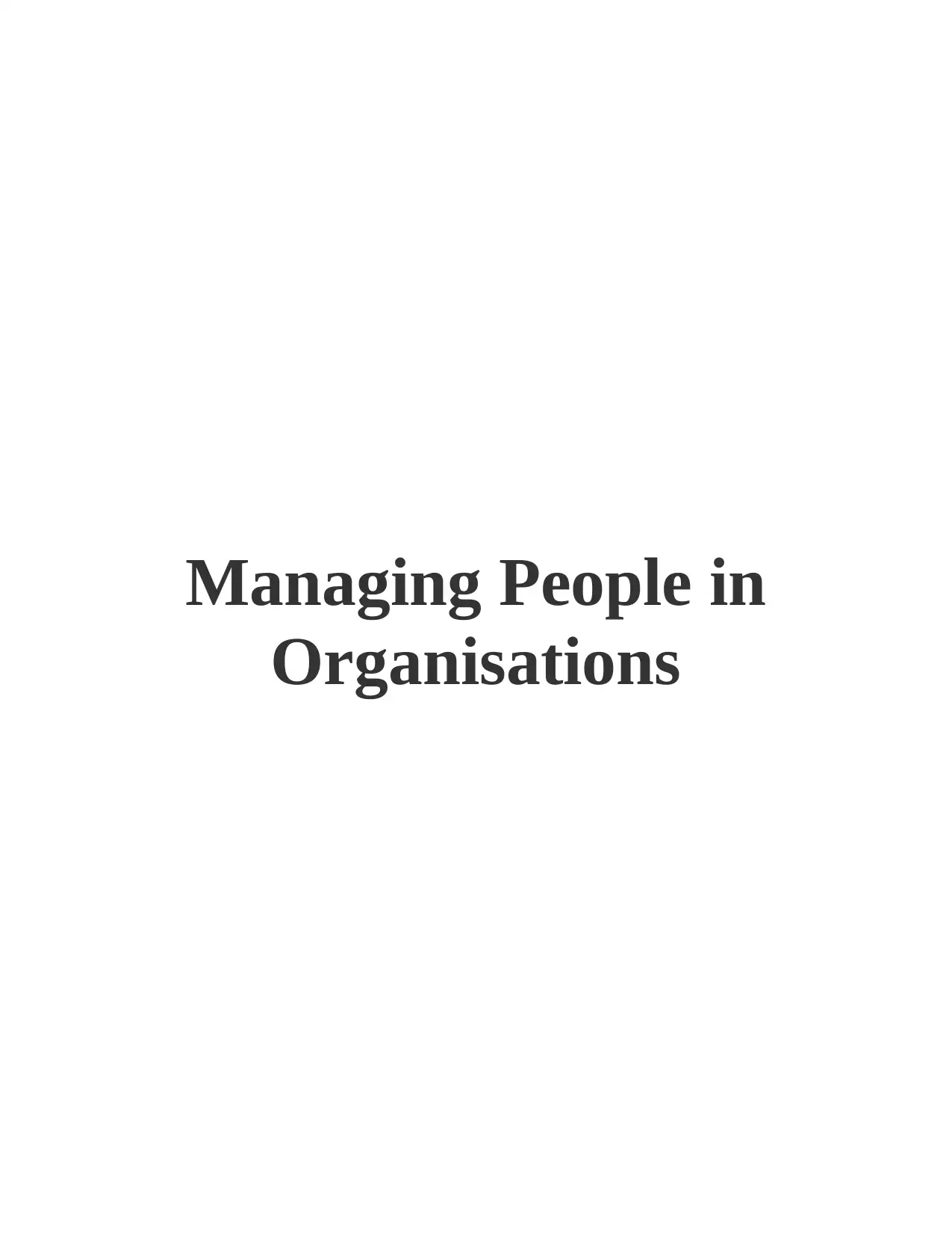
Managing People in
Organisations
Organisations
Paraphrase This Document
Need a fresh take? Get an instant paraphrase of this document with our AI Paraphraser
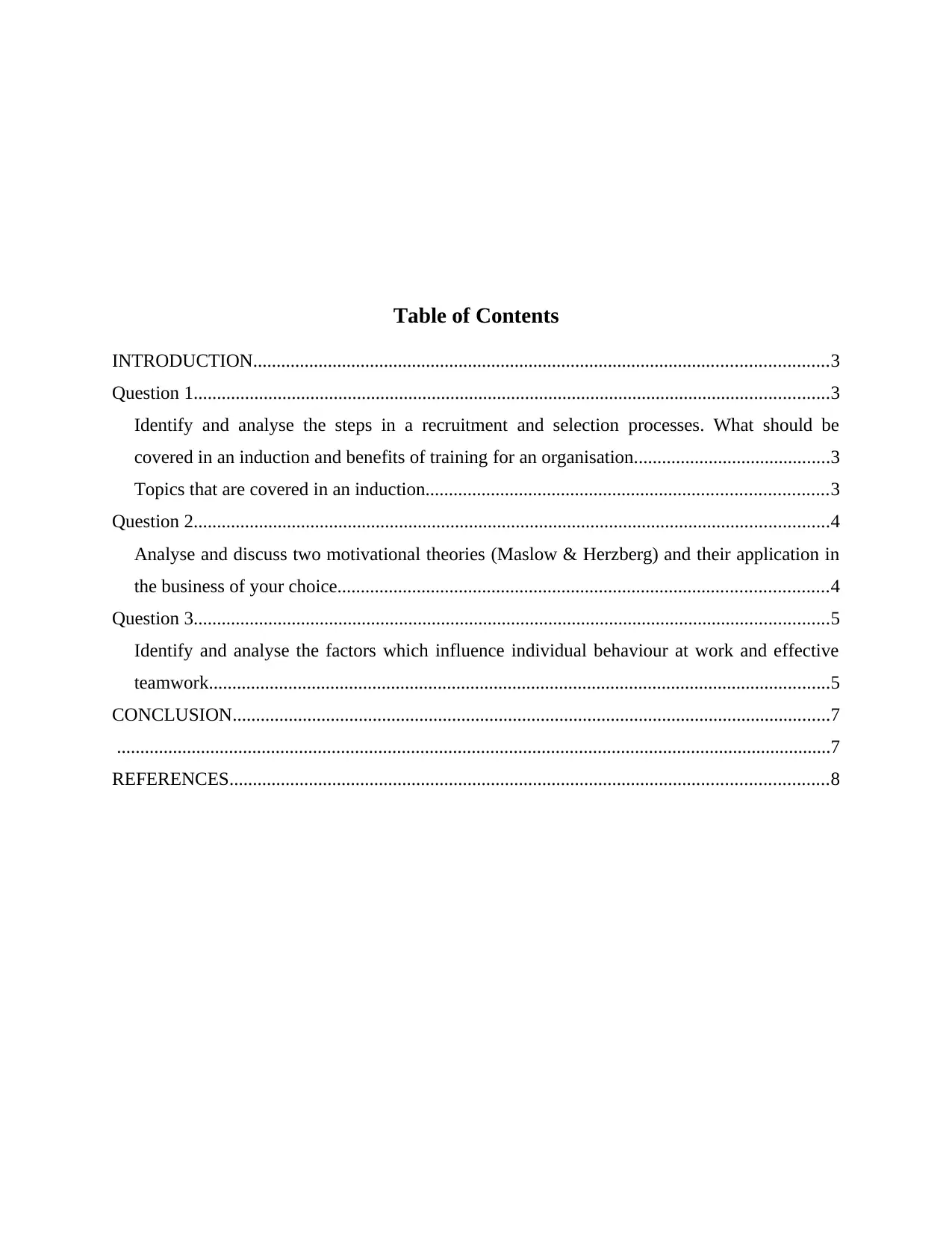
Table of Contents
INTRODUCTION...........................................................................................................................3
Question 1........................................................................................................................................3
Identify and analyse the steps in a recruitment and selection processes. What should be
covered in an induction and benefits of training for an organisation..........................................3
Topics that are covered in an induction......................................................................................3
Question 2........................................................................................................................................4
Analyse and discuss two motivational theories (Maslow & Herzberg) and their application in
the business of your choice.........................................................................................................4
Question 3........................................................................................................................................5
Identify and analyse the factors which influence individual behaviour at work and effective
teamwork.....................................................................................................................................5
CONCLUSION................................................................................................................................7
.........................................................................................................................................................7
REFERENCES................................................................................................................................8
INTRODUCTION...........................................................................................................................3
Question 1........................................................................................................................................3
Identify and analyse the steps in a recruitment and selection processes. What should be
covered in an induction and benefits of training for an organisation..........................................3
Topics that are covered in an induction......................................................................................3
Question 2........................................................................................................................................4
Analyse and discuss two motivational theories (Maslow & Herzberg) and their application in
the business of your choice.........................................................................................................4
Question 3........................................................................................................................................5
Identify and analyse the factors which influence individual behaviour at work and effective
teamwork.....................................................................................................................................5
CONCLUSION................................................................................................................................7
.........................................................................................................................................................7
REFERENCES................................................................................................................................8
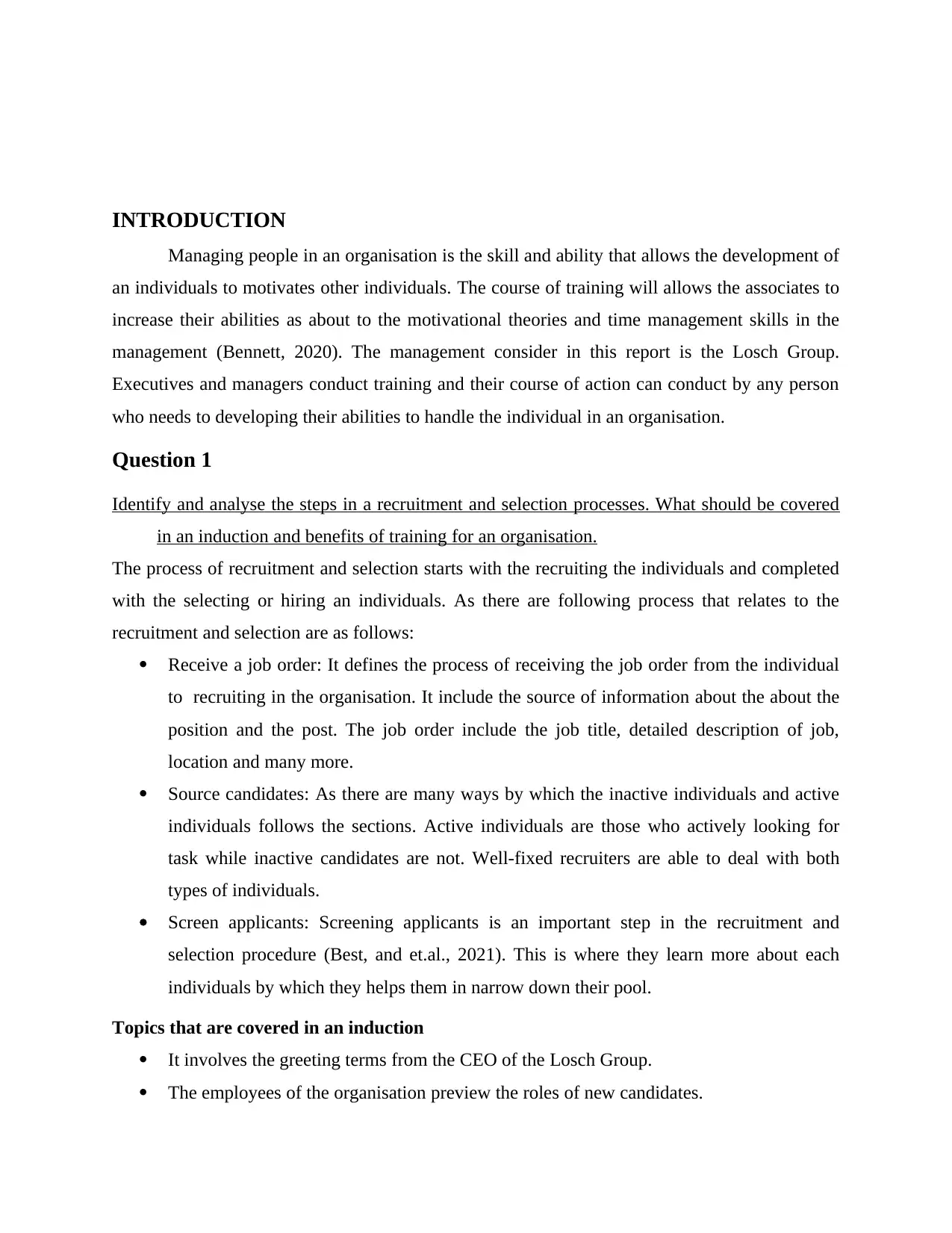
INTRODUCTION
Managing people in an organisation is the skill and ability that allows the development of
an individuals to motivates other individuals. The course of training will allows the associates to
increase their abilities as about to the motivational theories and time management skills in the
management (Bennett, 2020). The management consider in this report is the Losch Group.
Executives and managers conduct training and their course of action can conduct by any person
who needs to developing their abilities to handle the individual in an organisation.
Question 1
Identify and analyse the steps in a recruitment and selection processes. What should be covered
in an induction and benefits of training for an organisation.
The process of recruitment and selection starts with the recruiting the individuals and completed
with the selecting or hiring an individuals. As there are following process that relates to the
recruitment and selection are as follows:
Receive a job order: It defines the process of receiving the job order from the individual
to recruiting in the organisation. It include the source of information about the about the
position and the post. The job order include the job title, detailed description of job,
location and many more.
Source candidates: As there are many ways by which the inactive individuals and active
individuals follows the sections. Active individuals are those who actively looking for
task while inactive candidates are not. Well-fixed recruiters are able to deal with both
types of individuals.
Screen applicants: Screening applicants is an important step in the recruitment and
selection procedure (Best, and et.al., 2021). This is where they learn more about each
individuals by which they helps them in narrow down their pool.
Topics that are covered in an induction
It involves the greeting terms from the CEO of the Losch Group.
The employees of the organisation preview the roles of new candidates.
Managing people in an organisation is the skill and ability that allows the development of
an individuals to motivates other individuals. The course of training will allows the associates to
increase their abilities as about to the motivational theories and time management skills in the
management (Bennett, 2020). The management consider in this report is the Losch Group.
Executives and managers conduct training and their course of action can conduct by any person
who needs to developing their abilities to handle the individual in an organisation.
Question 1
Identify and analyse the steps in a recruitment and selection processes. What should be covered
in an induction and benefits of training for an organisation.
The process of recruitment and selection starts with the recruiting the individuals and completed
with the selecting or hiring an individuals. As there are following process that relates to the
recruitment and selection are as follows:
Receive a job order: It defines the process of receiving the job order from the individual
to recruiting in the organisation. It include the source of information about the about the
position and the post. The job order include the job title, detailed description of job,
location and many more.
Source candidates: As there are many ways by which the inactive individuals and active
individuals follows the sections. Active individuals are those who actively looking for
task while inactive candidates are not. Well-fixed recruiters are able to deal with both
types of individuals.
Screen applicants: Screening applicants is an important step in the recruitment and
selection procedure (Best, and et.al., 2021). This is where they learn more about each
individuals by which they helps them in narrow down their pool.
Topics that are covered in an induction
It involves the greeting terms from the CEO of the Losch Group.
The employees of the organisation preview the roles of new candidates.
⊘ This is a preview!⊘
Do you want full access?
Subscribe today to unlock all pages.

Trusted by 1+ million students worldwide
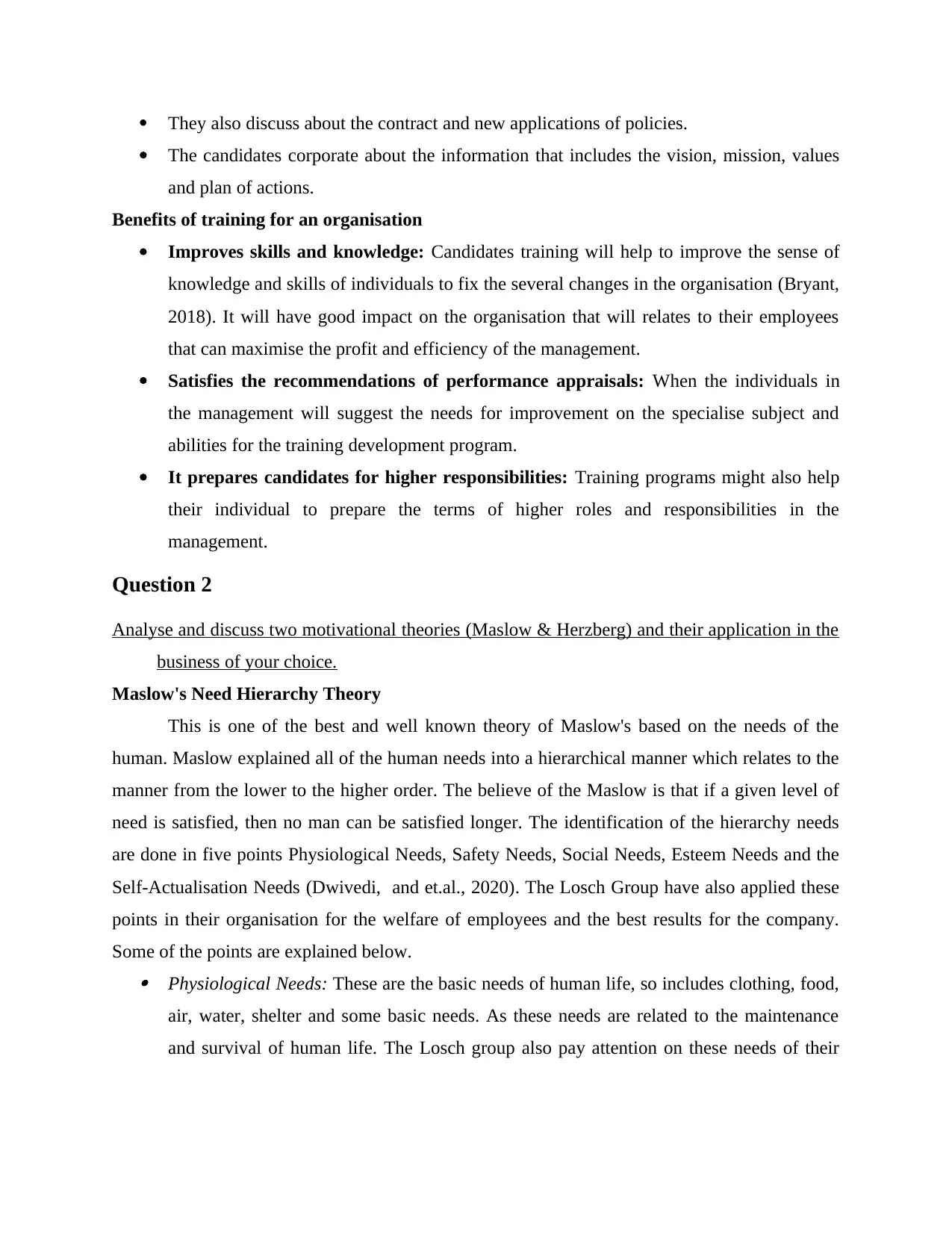
They also discuss about the contract and new applications of policies.
The candidates corporate about the information that includes the vision, mission, values
and plan of actions.
Benefits of training for an organisation
Improves skills and knowledge: Candidates training will help to improve the sense of
knowledge and skills of individuals to fix the several changes in the organisation (Bryant,
2018). It will have good impact on the organisation that will relates to their employees
that can maximise the profit and efficiency of the management.
Satisfies the recommendations of performance appraisals: When the individuals in
the management will suggest the needs for improvement on the specialise subject and
abilities for the training development program.
It prepares candidates for higher responsibilities: Training programs might also help
their individual to prepare the terms of higher roles and responsibilities in the
management.
Question 2
Analyse and discuss two motivational theories (Maslow & Herzberg) and their application in the
business of your choice.
Maslow's Need Hierarchy Theory
This is one of the best and well known theory of Maslow's based on the needs of the
human. Maslow explained all of the human needs into a hierarchical manner which relates to the
manner from the lower to the higher order. The believe of the Maslow is that if a given level of
need is satisfied, then no man can be satisfied longer. The identification of the hierarchy needs
are done in five points Physiological Needs, Safety Needs, Social Needs, Esteem Needs and the
Self-Actualisation Needs (Dwivedi, and et.al., 2020). The Losch Group have also applied these
points in their organisation for the welfare of employees and the best results for the company.
Some of the points are explained below. Physiological Needs: These are the basic needs of human life, so includes clothing, food,
air, water, shelter and some basic needs. As these needs are related to the maintenance
and survival of human life. The Losch group also pay attention on these needs of their
The candidates corporate about the information that includes the vision, mission, values
and plan of actions.
Benefits of training for an organisation
Improves skills and knowledge: Candidates training will help to improve the sense of
knowledge and skills of individuals to fix the several changes in the organisation (Bryant,
2018). It will have good impact on the organisation that will relates to their employees
that can maximise the profit and efficiency of the management.
Satisfies the recommendations of performance appraisals: When the individuals in
the management will suggest the needs for improvement on the specialise subject and
abilities for the training development program.
It prepares candidates for higher responsibilities: Training programs might also help
their individual to prepare the terms of higher roles and responsibilities in the
management.
Question 2
Analyse and discuss two motivational theories (Maslow & Herzberg) and their application in the
business of your choice.
Maslow's Need Hierarchy Theory
This is one of the best and well known theory of Maslow's based on the needs of the
human. Maslow explained all of the human needs into a hierarchical manner which relates to the
manner from the lower to the higher order. The believe of the Maslow is that if a given level of
need is satisfied, then no man can be satisfied longer. The identification of the hierarchy needs
are done in five points Physiological Needs, Safety Needs, Social Needs, Esteem Needs and the
Self-Actualisation Needs (Dwivedi, and et.al., 2020). The Losch Group have also applied these
points in their organisation for the welfare of employees and the best results for the company.
Some of the points are explained below. Physiological Needs: These are the basic needs of human life, so includes clothing, food,
air, water, shelter and some basic needs. As these needs are related to the maintenance
and survival of human life. The Losch group also pay attention on these needs of their
Paraphrase This Document
Need a fresh take? Get an instant paraphrase of this document with our AI Paraphraser
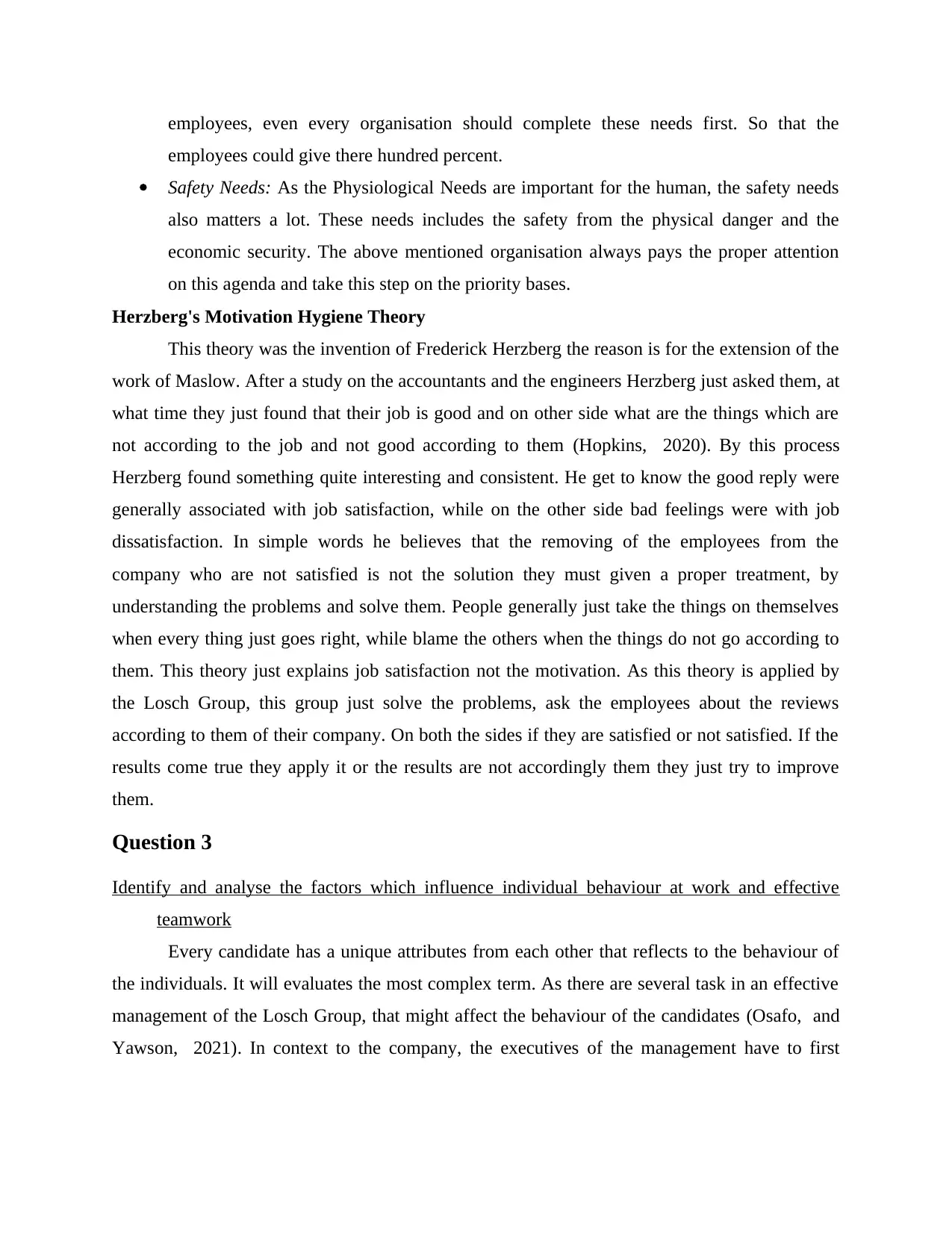
employees, even every organisation should complete these needs first. So that the
employees could give there hundred percent.
Safety Needs: As the Physiological Needs are important for the human, the safety needs
also matters a lot. These needs includes the safety from the physical danger and the
economic security. The above mentioned organisation always pays the proper attention
on this agenda and take this step on the priority bases.
Herzberg's Motivation Hygiene Theory
This theory was the invention of Frederick Herzberg the reason is for the extension of the
work of Maslow. After a study on the accountants and the engineers Herzberg just asked them, at
what time they just found that their job is good and on other side what are the things which are
not according to the job and not good according to them (Hopkins, 2020). By this process
Herzberg found something quite interesting and consistent. He get to know the good reply were
generally associated with job satisfaction, while on the other side bad feelings were with job
dissatisfaction. In simple words he believes that the removing of the employees from the
company who are not satisfied is not the solution they must given a proper treatment, by
understanding the problems and solve them. People generally just take the things on themselves
when every thing just goes right, while blame the others when the things do not go according to
them. This theory just explains job satisfaction not the motivation. As this theory is applied by
the Losch Group, this group just solve the problems, ask the employees about the reviews
according to them of their company. On both the sides if they are satisfied or not satisfied. If the
results come true they apply it or the results are not accordingly them they just try to improve
them.
Question 3
Identify and analyse the factors which influence individual behaviour at work and effective
teamwork
Every candidate has a unique attributes from each other that reflects to the behaviour of
the individuals. It will evaluates the most complex term. As there are several task in an effective
management of the Losch Group, that might affect the behaviour of the candidates (Osafo, and
Yawson, 2021). In context to the company, the executives of the management have to first
employees could give there hundred percent.
Safety Needs: As the Physiological Needs are important for the human, the safety needs
also matters a lot. These needs includes the safety from the physical danger and the
economic security. The above mentioned organisation always pays the proper attention
on this agenda and take this step on the priority bases.
Herzberg's Motivation Hygiene Theory
This theory was the invention of Frederick Herzberg the reason is for the extension of the
work of Maslow. After a study on the accountants and the engineers Herzberg just asked them, at
what time they just found that their job is good and on other side what are the things which are
not according to the job and not good according to them (Hopkins, 2020). By this process
Herzberg found something quite interesting and consistent. He get to know the good reply were
generally associated with job satisfaction, while on the other side bad feelings were with job
dissatisfaction. In simple words he believes that the removing of the employees from the
company who are not satisfied is not the solution they must given a proper treatment, by
understanding the problems and solve them. People generally just take the things on themselves
when every thing just goes right, while blame the others when the things do not go according to
them. This theory just explains job satisfaction not the motivation. As this theory is applied by
the Losch Group, this group just solve the problems, ask the employees about the reviews
according to them of their company. On both the sides if they are satisfied or not satisfied. If the
results come true they apply it or the results are not accordingly them they just try to improve
them.
Question 3
Identify and analyse the factors which influence individual behaviour at work and effective
teamwork
Every candidate has a unique attributes from each other that reflects to the behaviour of
the individuals. It will evaluates the most complex term. As there are several task in an effective
management of the Losch Group, that might affect the behaviour of the candidates (Osafo, and
Yawson, 2021). In context to the company, the executives of the management have to first
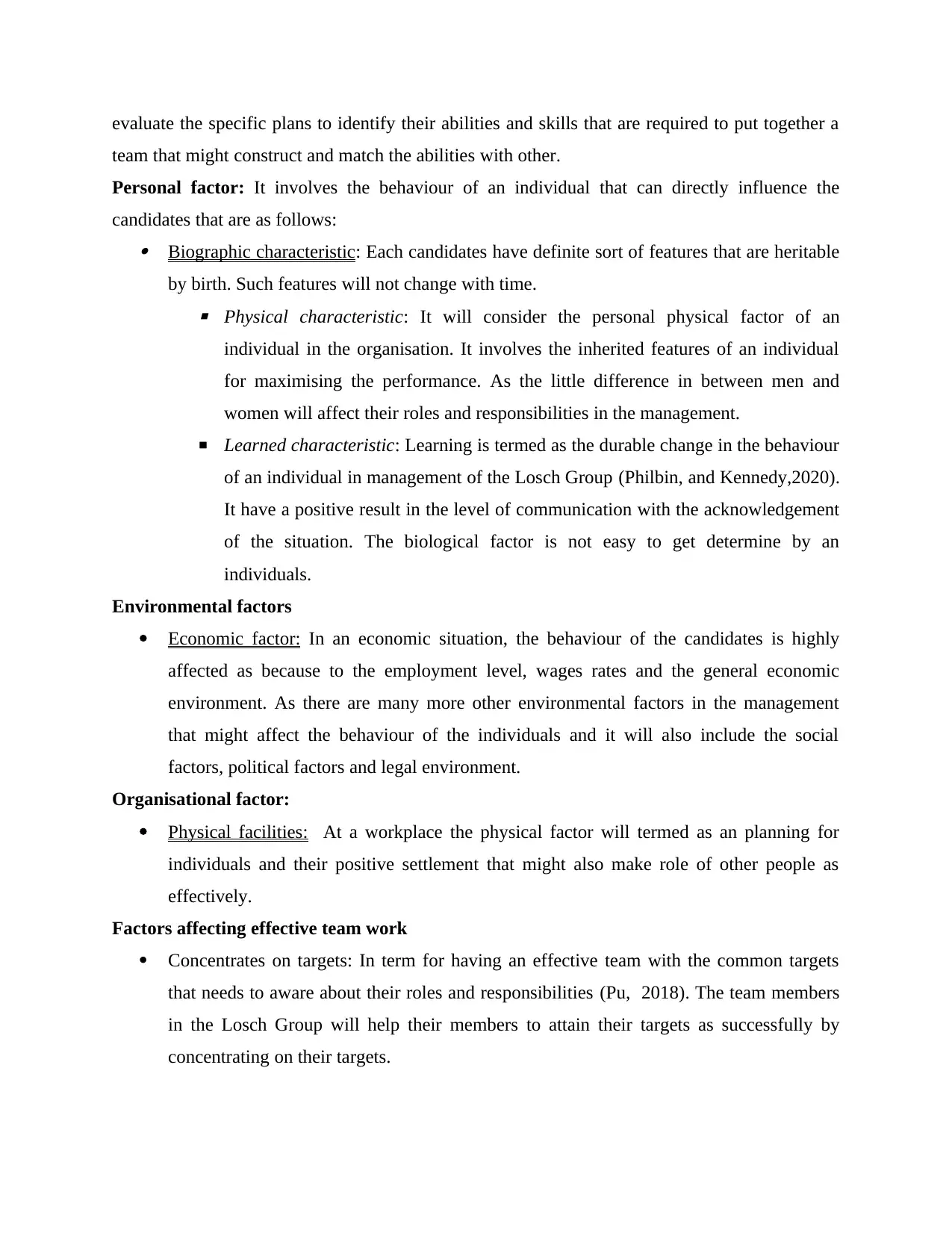
evaluate the specific plans to identify their abilities and skills that are required to put together a
team that might construct and match the abilities with other.
Personal factor: It involves the behaviour of an individual that can directly influence the
candidates that are as follows: Biographic characteristic: Each candidates have definite sort of features that are heritable
by birth. Such features will not change with time.
▪ Physical characteristic: It will consider the personal physical factor of an
individual in the organisation. It involves the inherited features of an individual
for maximising the performance. As the little difference in between men and
women will affect their roles and responsibilities in the management.
▪ Learned characteristic: Learning is termed as the durable change in the behaviour
of an individual in management of the Losch Group (Philbin, and Kennedy,2020).
It have a positive result in the level of communication with the acknowledgement
of the situation. The biological factor is not easy to get determine by an
individuals.
Environmental factors
Economic factor: In an economic situation, the behaviour of the candidates is highly
affected as because to the employment level, wages rates and the general economic
environment. As there are many more other environmental factors in the management
that might affect the behaviour of the individuals and it will also include the social
factors, political factors and legal environment.
Organisational factor:
Physical facilities: At a workplace the physical factor will termed as an planning for
individuals and their positive settlement that might also make role of other people as
effectively.
Factors affecting effective team work
Concentrates on targets: In term for having an effective team with the common targets
that needs to aware about their roles and responsibilities (Pu, 2018). The team members
in the Losch Group will help their members to attain their targets as successfully by
concentrating on their targets.
team that might construct and match the abilities with other.
Personal factor: It involves the behaviour of an individual that can directly influence the
candidates that are as follows: Biographic characteristic: Each candidates have definite sort of features that are heritable
by birth. Such features will not change with time.
▪ Physical characteristic: It will consider the personal physical factor of an
individual in the organisation. It involves the inherited features of an individual
for maximising the performance. As the little difference in between men and
women will affect their roles and responsibilities in the management.
▪ Learned characteristic: Learning is termed as the durable change in the behaviour
of an individual in management of the Losch Group (Philbin, and Kennedy,2020).
It have a positive result in the level of communication with the acknowledgement
of the situation. The biological factor is not easy to get determine by an
individuals.
Environmental factors
Economic factor: In an economic situation, the behaviour of the candidates is highly
affected as because to the employment level, wages rates and the general economic
environment. As there are many more other environmental factors in the management
that might affect the behaviour of the individuals and it will also include the social
factors, political factors and legal environment.
Organisational factor:
Physical facilities: At a workplace the physical factor will termed as an planning for
individuals and their positive settlement that might also make role of other people as
effectively.
Factors affecting effective team work
Concentrates on targets: In term for having an effective team with the common targets
that needs to aware about their roles and responsibilities (Pu, 2018). The team members
in the Losch Group will help their members to attain their targets as successfully by
concentrating on their targets.
⊘ This is a preview!⊘
Do you want full access?
Subscribe today to unlock all pages.

Trusted by 1+ million students worldwide
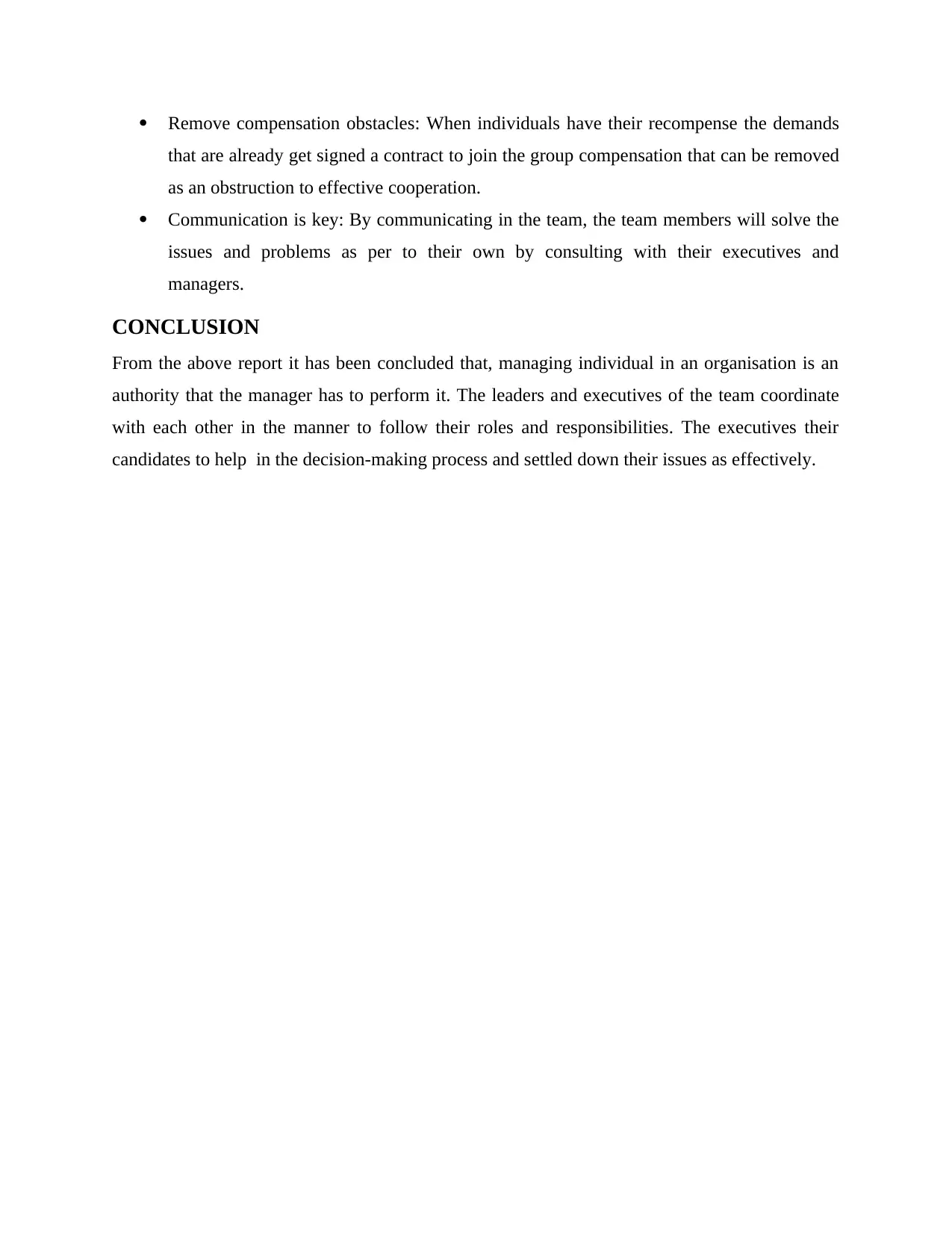
Remove compensation obstacles: When individuals have their recompense the demands
that are already get signed a contract to join the group compensation that can be removed
as an obstruction to effective cooperation.
Communication is key: By communicating in the team, the team members will solve the
issues and problems as per to their own by consulting with their executives and
managers.
CONCLUSION
From the above report it has been concluded that, managing individual in an organisation is an
authority that the manager has to perform it. The leaders and executives of the team coordinate
with each other in the manner to follow their roles and responsibilities. The executives their
candidates to help in the decision-making process and settled down their issues as effectively.
that are already get signed a contract to join the group compensation that can be removed
as an obstruction to effective cooperation.
Communication is key: By communicating in the team, the team members will solve the
issues and problems as per to their own by consulting with their executives and
managers.
CONCLUSION
From the above report it has been concluded that, managing individual in an organisation is an
authority that the manager has to perform it. The leaders and executives of the team coordinate
with each other in the manner to follow their roles and responsibilities. The executives their
candidates to help in the decision-making process and settled down their issues as effectively.
Paraphrase This Document
Need a fresh take? Get an instant paraphrase of this document with our AI Paraphraser
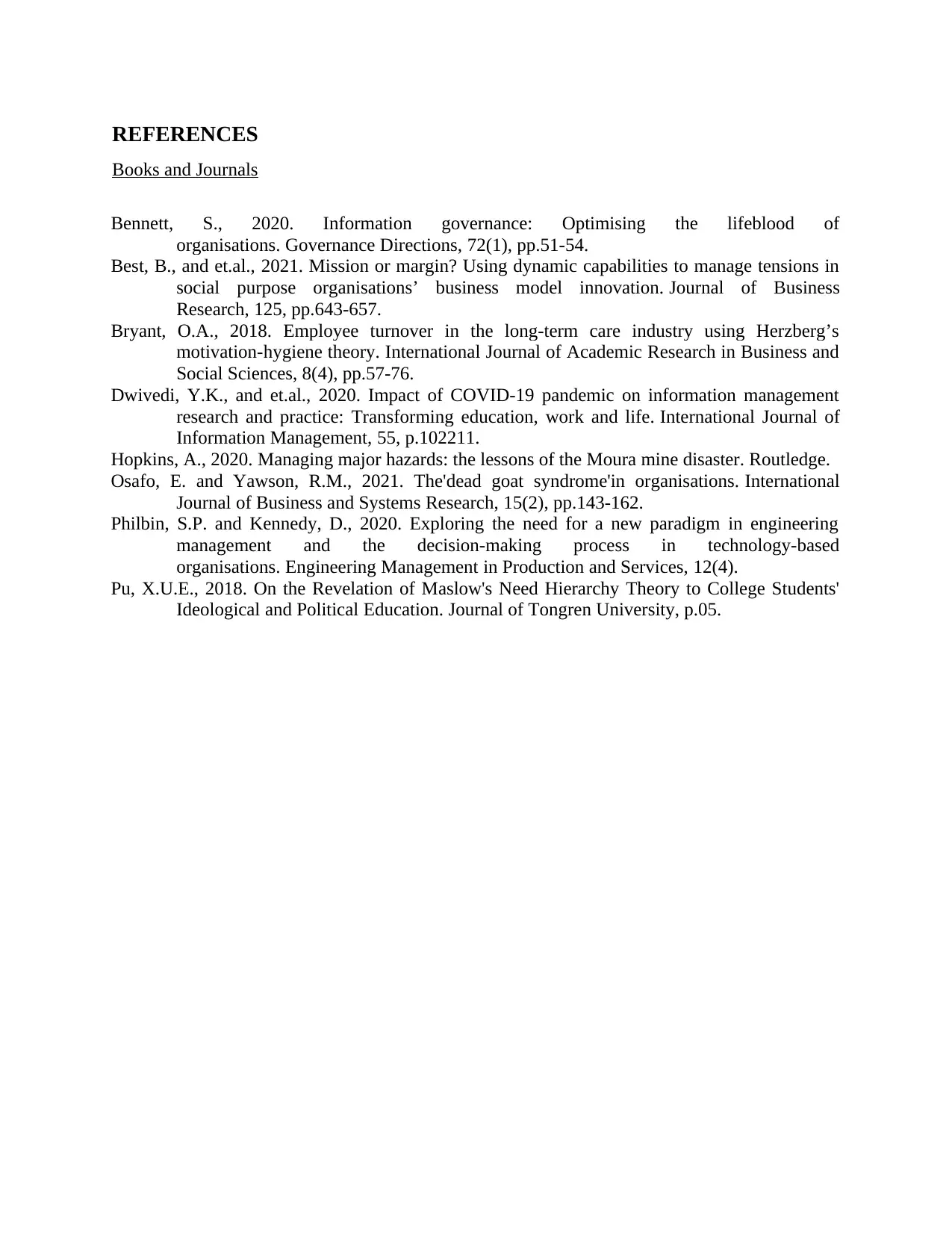
REFERENCES
Books and Journals
Bennett, S., 2020. Information governance: Optimising the lifeblood of
organisations. Governance Directions, 72(1), pp.51-54.
Best, B., and et.al., 2021. Mission or margin? Using dynamic capabilities to manage tensions in
social purpose organisations’ business model innovation. Journal of Business
Research, 125, pp.643-657.
Bryant, O.A., 2018. Employee turnover in the long-term care industry using Herzberg’s
motivation-hygiene theory. International Journal of Academic Research in Business and
Social Sciences, 8(4), pp.57-76.
Dwivedi, Y.K., and et.al., 2020. Impact of COVID-19 pandemic on information management
research and practice: Transforming education, work and life. International Journal of
Information Management, 55, p.102211.
Hopkins, A., 2020. Managing major hazards: the lessons of the Moura mine disaster. Routledge.
Osafo, E. and Yawson, R.M., 2021. The'dead goat syndrome'in organisations. International
Journal of Business and Systems Research, 15(2), pp.143-162.
Philbin, S.P. and Kennedy, D., 2020. Exploring the need for a new paradigm in engineering
management and the decision-making process in technology-based
organisations. Engineering Management in Production and Services, 12(4).
Pu, X.U.E., 2018. On the Revelation of Maslow's Need Hierarchy Theory to College Students'
Ideological and Political Education. Journal of Tongren University, p.05.
Books and Journals
Bennett, S., 2020. Information governance: Optimising the lifeblood of
organisations. Governance Directions, 72(1), pp.51-54.
Best, B., and et.al., 2021. Mission or margin? Using dynamic capabilities to manage tensions in
social purpose organisations’ business model innovation. Journal of Business
Research, 125, pp.643-657.
Bryant, O.A., 2018. Employee turnover in the long-term care industry using Herzberg’s
motivation-hygiene theory. International Journal of Academic Research in Business and
Social Sciences, 8(4), pp.57-76.
Dwivedi, Y.K., and et.al., 2020. Impact of COVID-19 pandemic on information management
research and practice: Transforming education, work and life. International Journal of
Information Management, 55, p.102211.
Hopkins, A., 2020. Managing major hazards: the lessons of the Moura mine disaster. Routledge.
Osafo, E. and Yawson, R.M., 2021. The'dead goat syndrome'in organisations. International
Journal of Business and Systems Research, 15(2), pp.143-162.
Philbin, S.P. and Kennedy, D., 2020. Exploring the need for a new paradigm in engineering
management and the decision-making process in technology-based
organisations. Engineering Management in Production and Services, 12(4).
Pu, X.U.E., 2018. On the Revelation of Maslow's Need Hierarchy Theory to College Students'
Ideological and Political Education. Journal of Tongren University, p.05.

⊘ This is a preview!⊘
Do you want full access?
Subscribe today to unlock all pages.

Trusted by 1+ million students worldwide
1 out of 9
Related Documents
Your All-in-One AI-Powered Toolkit for Academic Success.
+13062052269
info@desklib.com
Available 24*7 on WhatsApp / Email
![[object Object]](/_next/static/media/star-bottom.7253800d.svg)
Unlock your academic potential
Copyright © 2020–2025 A2Z Services. All Rights Reserved. Developed and managed by ZUCOL.




